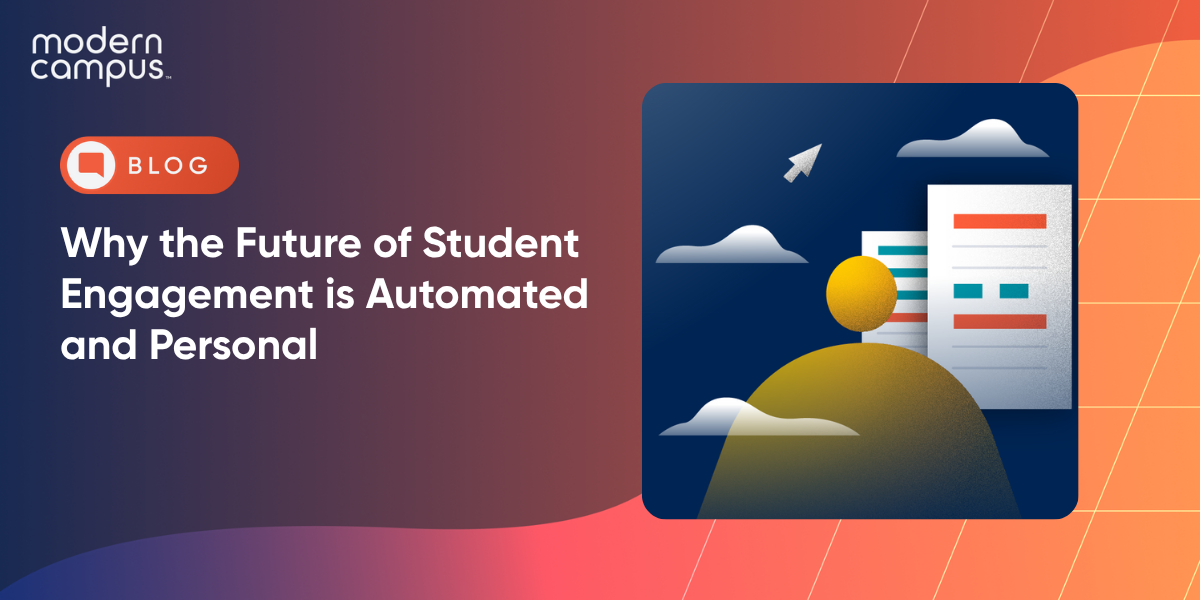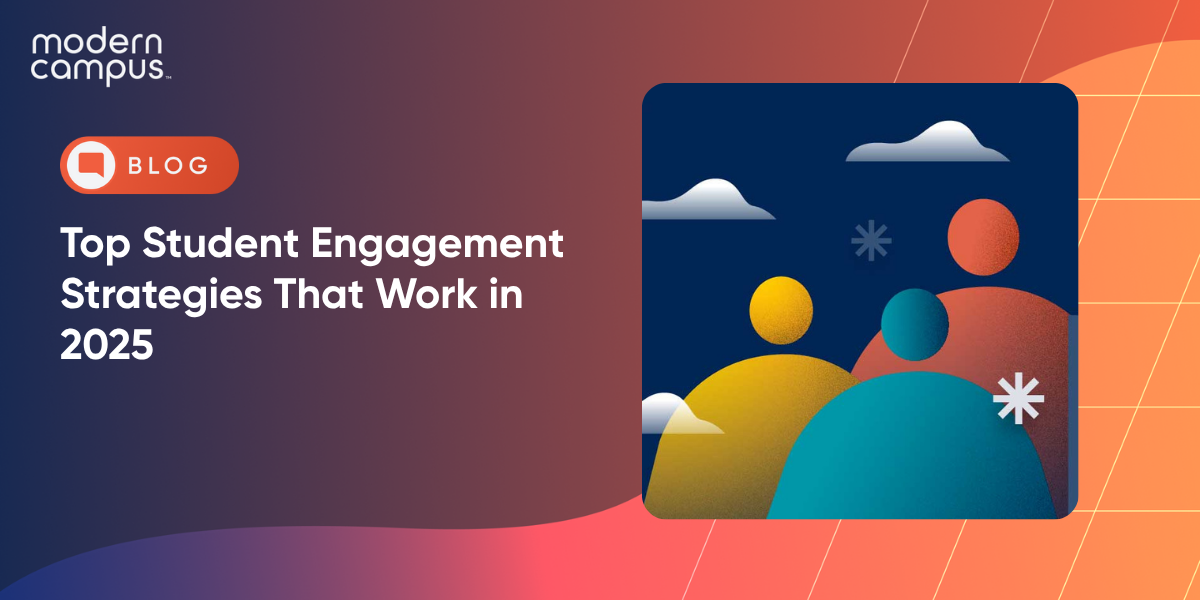Why the Future of Student Engagement is Automated and Personal
AI-Driven Platforms Transform Campus Communication, Creating Deeper, More Meaningful Student Connections
Student engagement is evolving from one-size-fits-all approaches to sophisticated, automated personalization that scales human connection rather than replacing it.
- AI-powered platforms deliver targeted interventions and predict at-risk behaviors before traditional metrics would flag concerns.
- Personalized communication based on behavioral data creates higher retention rates compared to traditional methods.
- Automated systems free staff to focus on meaningful human interactions while ensuring no student falls through the cracks.
- The most successful institutions combine data intelligence with human empathy to support students exactly when and how they need it.
The institutions winning in 2025 understand that technology makes better relationships possible.
Higher education is a complex environment where two-thirds of college students report feeling lonely, and more than one million college students drop out each year. Yet something remarkable is happening at forward-thinking institutions across the country. They're discovering that the solution is smarter, more strategic touchpoints powered by modern student engagement platforms that know exactly when students need support.
The future of higher ed revolves around amplifying interactions through intelligent systems that can track, predict and respond to student needs at scale. Successful institutions understand that genuine personalization requires both data intelligence and human empathy working in perfect harmony.
What Does an Automated Student Engagement Platform Actually Look Like?
Consider this scenario: A first-year student misses two consecutive biology classes. Within hours, she receives a personalized text message from her academic advisor asking if everything's okay and offering specific resources. The message doesn't feel robotic because it references her declared pre-med track and mentions upcoming resources that align with her goals.
Scenarios similar to this example are happening at institutions leveraging modern student engagement platforms. AI-powered learning tools are increasingly integrating into higher education, offering benefits such as personalized learning experiences, real-time feedback and increased flexibility.
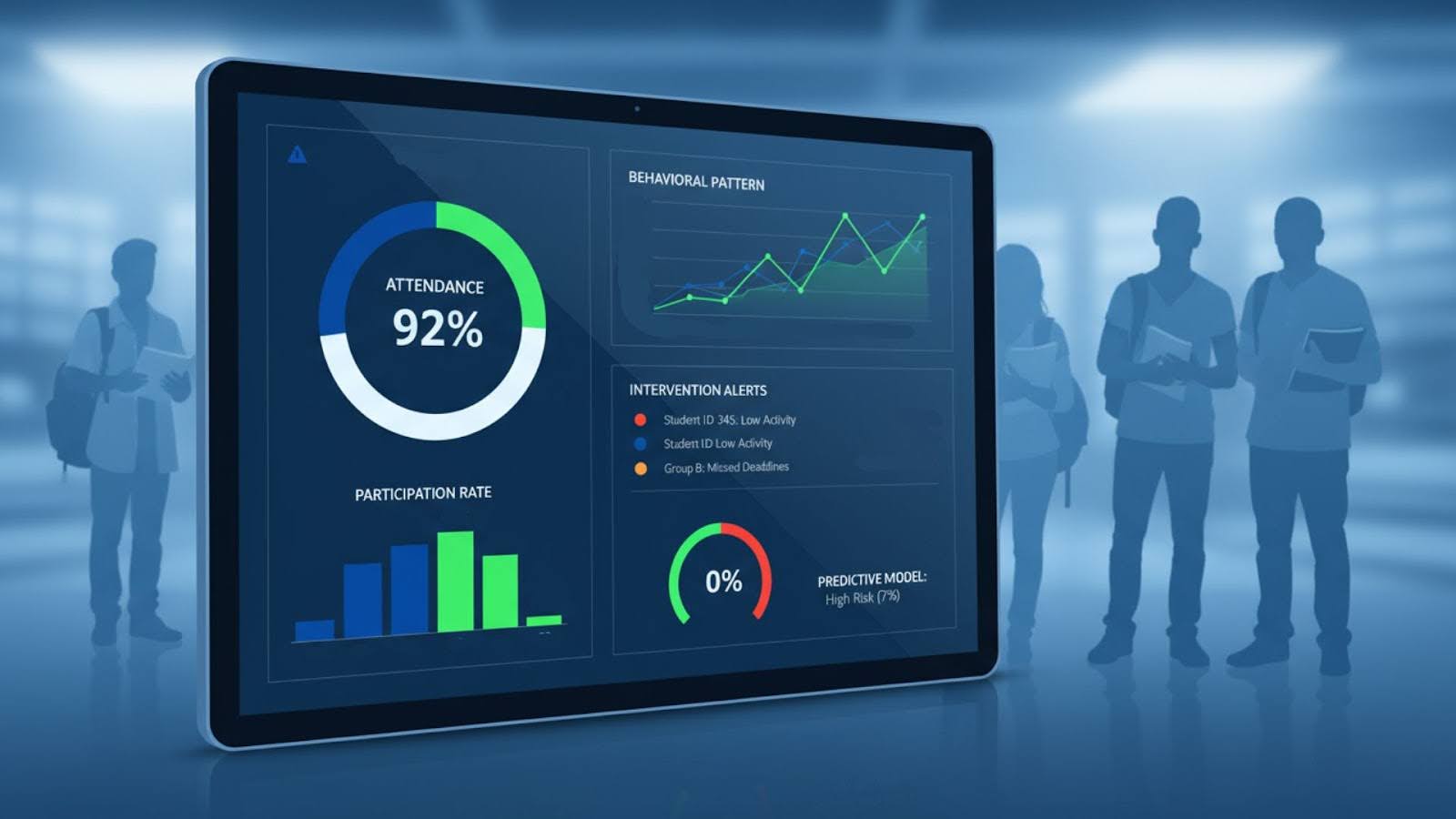
Today's most effective student success tools operate on behavioral triggers rather than scheduled check-ins. When a student's engagement patterns change, automated systems can flag potential issues and route them to appropriate support staff. These platforms act on data with the same urgency a caring professor would, but at a scale that can cover thousands of students simultaneously.
Higher ed automation has evolved from performing basic administrative tasks to sophisticated engagement orchestration. Students now receive personalized content recommendations, timely reminders about financial aid deadlines and invitations to events that match their interests and academic goals. The result is communication that feels personalized because it’s actually personal, just delivered through intelligent systems.
Why Does One-Size-Fits-All Communication Kill Student Success?
The traditional mass email blast is ineffective and harmful to engagement. When students receive generic communications that don't align with their needs, academic status or life circumstances, they learn to ignore all institutional messaging. It creates a trust deficit that compounds over time.
Consider the difference between sending every junior the same "register for classes" reminder versus sending personalized messages that reference their specific degree progress, flag prerequisite issues and suggest courses that align with their career pathway data. Institutions using hyper-personalization in student communications see higher response rates and engagement levels.
Modern campus messaging platforms leverage student information system data to create deeply contextual communications. For example:
- A student who struggles with calculus gets different messaging about math resources than a student who aced the course but is considering changing majors.
- A working parent receives information about evening child care availability during finals week, while traditional students get study group formation prompts.
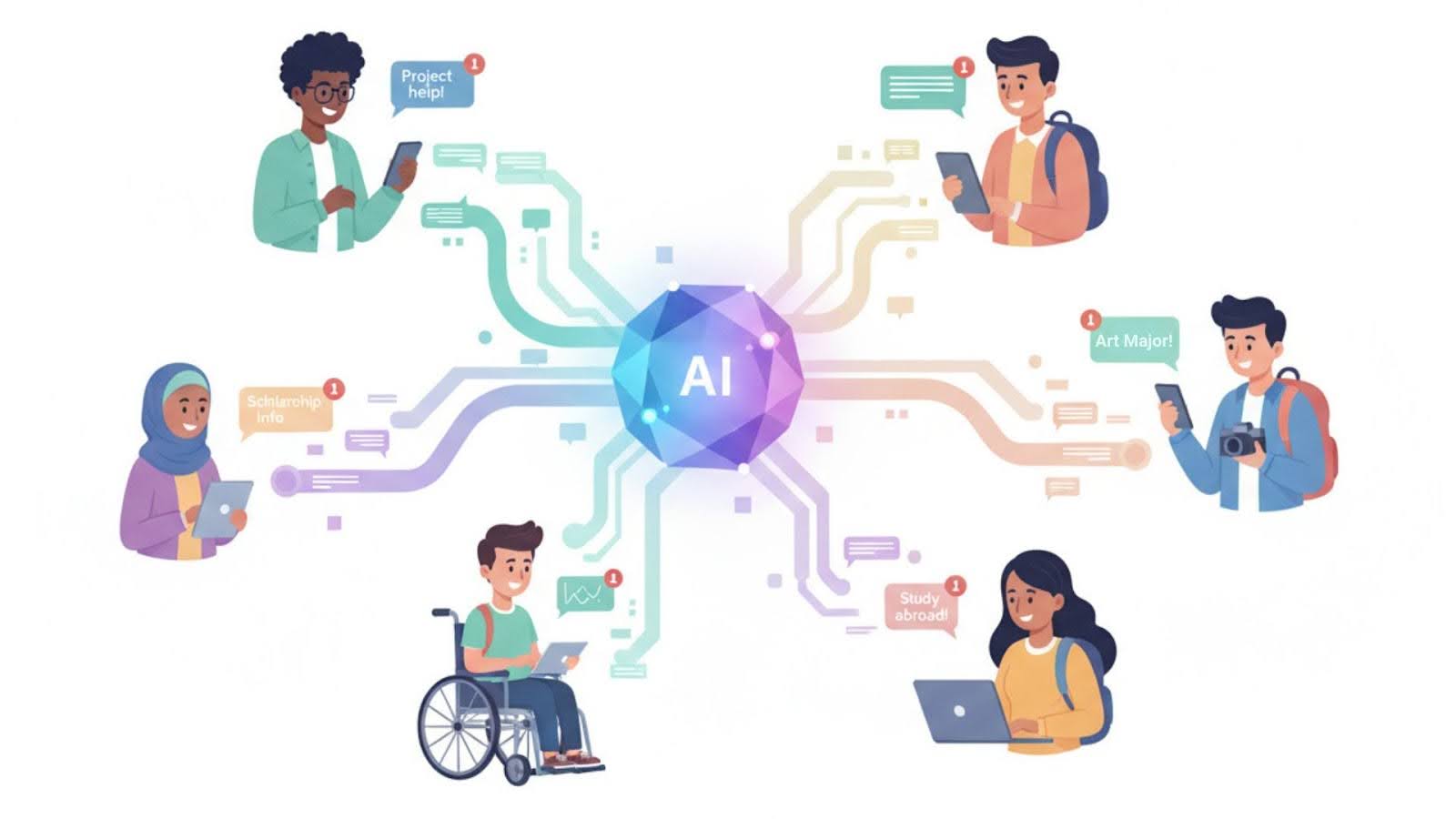
Personalization extends to behavioral patterns. Students who typically engage with text messages get SMS communications, while email-preferring students receive detailed newsletters. Some respond better to peer success stories, others to direct administrative information. Effective student engagement requires meeting students where they already are.
The most sophisticated student engagement platforms analyze sentiment in student communications, flagging distress signals that might be missed in traditional advising appointments. When concerning patterns emerge in student communication, human advisors receive alerts that enable proactive intervention rather than reactive crisis management.
How Can Higher Ed Automation Enhance Rather Than Replace Human Connection?
The fear that technology will dehumanize education misses the potential of thoughtfully implemented automation. The goal is to ensure every human interaction is meaningful, timely and informed by comprehensive student data.
Faculty and staff time is precious and limited. When administrative tasks like appointment scheduling, transcript requests and basic FAQ responses are handled automatically, educators can focus on teaching, mentoring and supporting students through complex challenges. AI technologies enable real-time analysis of vast amounts of data, offering advantages in identifying at-risk students, recommending personalized interventions and facilitating timely feedback.

Higher ed automation excels at pattern recognition that humans might miss. These systems can identify students who may benefit from additional support resources, enabling proactive outreach that feels supportive rather than punitive. They can recognize trends that help institutions provide enhanced support before problems arise.
The most effective student success tools create what researchers call "augmented advising," where human advisors receive comprehensive dashboards showing each student's engagement patterns, academic trajectory and potential intervention needs. Instead of spending time gathering basic information, advisors can dive immediately into meaningful conversations about goals, challenges and solutions.
Consider predictive analytics that identify students likely to change majors based on course performance and engagement patterns. Rather than waiting for students to realize this themselves (often after accumulating excess credits and debt), advisors can proactively discuss alternative pathways and ensure smooth transitions. The most impactful personalized student engagement uses data to facilitate better human conversations.
5 Ways Automation Transforms Student Engagement
The most successful institutions leverage automation as a strategic amplifier that ensures every student interaction is timely, relevant and actionable. Here's how leading student engagement platforms are reshaping campus communication:
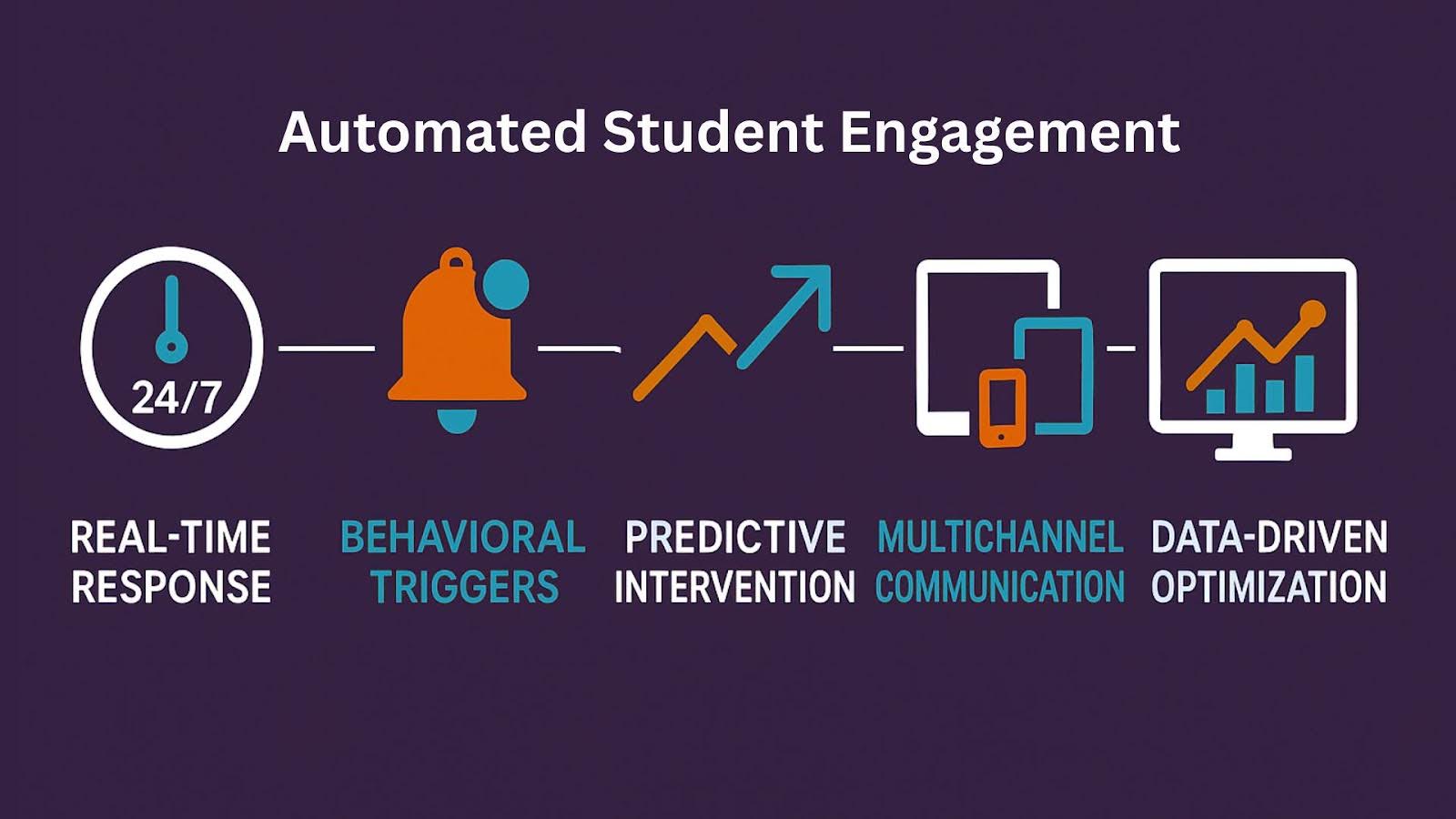
1. Real-Time Response Capabilities
Automated systems never sleep, ensuring students receive immediate responses to common questions about deadlines, requirements and resources. This instant gratification meets modern expectations while freeing staff to handle complex inquiries requiring human judgment.
2. Behavioral Trigger Messaging
Instead of generic weekly newsletters, students receive communications triggered by their specific actions or inactions. Missed an important deadline? An automatic email with extension options lands in a student’s inbox. Haven't accessed the career center? A personalized invitation to relevant networking opportunities pops up on a student’s phone.
3. Predictive Intervention
Advanced analytics identify at-risk students before traditional metrics would flag concerns. Students showing signs of disengagement receive support resources proactively, helping improve retention rates.
4. Multichannel Communication Orchestration
Students receive information through their preferred channels, such as SMS for urgent notifications, email for detailed information or in-app messages for course-specific updates. The platform learns and adapts to individual communication preferences.
5. Data-Driven Optimization
Every communication is tracked and analyzed for effectiveness. Messages that generate positive responses are refined and replicated, while ineffective communications are eliminated. This evaluation creates continuously improving engagement strategies based on actual student behavior rather than assumptions.
The Implementation Reality: What Success Actually Requires
The transition to automated, personalized engagement requires shifting how institutions approach student communication and support. Educational technology leaders emphasize that successful AI implementation in higher education makes learning more personalized, efficient and accessible.
Start with Clear Objectives. Successful institutions define their goals:
- Are you trying to improve retention?
- Increase engagement?
- Streamline administrative processes?
The most effective student engagement platforms align technology capabilities with specific institutional goals and student needs.
Overcoming Data Integration Challenges. Data integration presents the biggest technical challenge. Student information scattered across multiple systems: SIS, LMS, dining services, housing, library systems and more.
To enable truly personalized communication, this data must be unified into comprehensive student profiles. Doing so requires both technical infrastructure and organizational commitment to data standardization.
Rethinking Staff Training. Effective staff training goes beyond technical proficiency. Advisors and staff need to learn how to:
- Think strategically about student engagement
- Understand how to interpret analytics
- Use customized automated messaging and technology-generated insights to enhance interactions with students
Addressing Privacy and Consent. Privacy and consent considerations require careful navigation. Students must understand:
- What data is being collected
- How it's being used
- What benefits they receive in return
Transparent communication about the purpose and benefits of data collection builds trust and confidence in institutional practices.
Using Automation to Enhance Student Success. The most successful implementations treat automation as an enhancement to existing student success strategies. Technology should amplify good practices and make ineffective approaches more obviously problematic, requiring institutions to honestly evaluate their engagement methods.
Frequently Asked Questions
How do students react to automated messaging and AI-driven communication? When implemented thoughtfully, students respond positively to personalized automation because it feels more relevant and helpful than generic mass communications. The key is transparency about what data is being used and ensuring messages provide genuine value rather than just pushing institutional priorities.
What about student privacy concerns with all this data collection? Successful programs maintain strict data governance policies, provide clear opt-in/opt-out mechanisms and focus on using data to benefit students rather than solely on institutional metrics. Students are generally willing to share data when they see direct benefits like timely support and relevant resources.
How do institutions measure the success of automated engagement platforms? Effective measurement tracks meaningful outcomes like:
- Student retention
- Time-to-degree completion
- Utilization of support services
- Student satisfaction with communication
The best platforms provide comprehensive analytics that tie engagement activities to academic success metrics.
Enhance Your Student Engagement Strategy
The shift toward automated, personalized student engagement impacts how institutions demonstrate care for their students. By combining the efficiency of automation with the insight of human expertise, colleges and universities can finally deliver the individualized attention that every student deserves at a scale their resources can sustain.
When every communication is relevant, every intervention is timely and every interaction is informed by comprehensive student data, both students and staff experience education as it was always meant to be: deeply personal, genuinely supportive and focused on individual success. Modern Campus helps you build lasting relationships with learners through intelligent automation that enhances rather than replaces human connection.
Last updated: October 27, 2025
